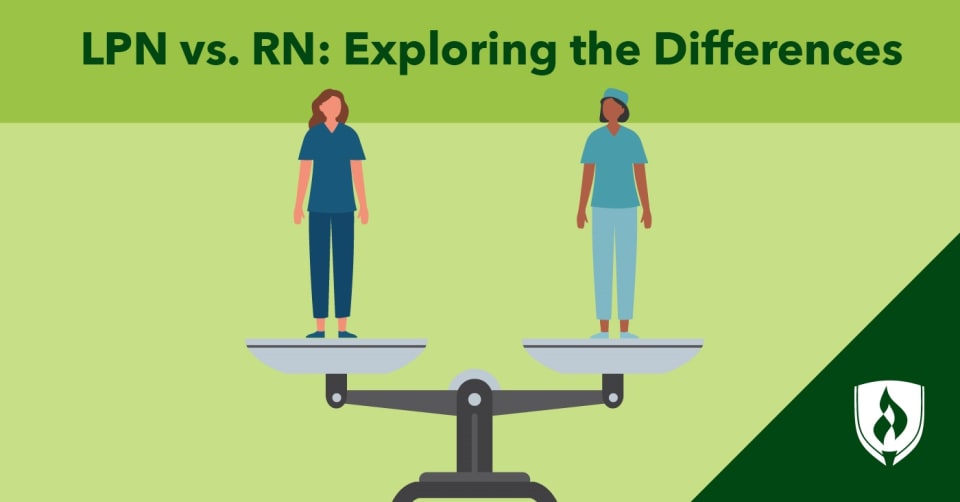
You’ve had some time to consider what you’d like to do for a living and starting a nursing career remains a top option. Nurses play a much-needed role in our healthcare system and can make a positive impact on the lives of their patients. You’d love to earn a living boosting the spirits and vitality of the people in your community, but there’s more you’ll want to get sorted out before diving into nursing school.
One of the biggest is understanding the differences between two common types of nurses: licensed practical nurses (LPNs) and registered nurses (RNs). In this article, we’ll compare the two so you’ll have a better handle on your nursing education options.
LPN vs. RN: What’s the difference?
Both LPNs and RNs directly care for patients and may even have some significant overlap in their daily duties, but they are not the same. The main differences between LPNs and RNs are centered on their scopes of practice and the amount of education required to obtain licensure. While the specifics can vary somewhat depending on the state they are licensed to work in, RNs will generally have a broader scope of practice and potential responsibilities than LPNs. This expanded range of potential duties goes hand-in-hand with the level of education and training received—RNs have a longer academic path to fulfill before obtaining licensure.
While there’s a clear distinction between these roles, it isn’t always an easy decision for prospective nurses to choose between becoming an LPN or an RN. The right answer will depend on your skills, long-term career aspirations, academic ability and personal situation. Both options for becoming a nurse can have advantages and disadvantages, so let’s walk through some of the key comparison points you’ll want to consider.
LPN vs. RN: Job duties
While the specific job duties can vary substantially depending on the work setting and/or specialty focus, there are some generalizations we can make regarding LPN and RN job duties.
Licensed practical nurses typically provide basic nursing care, like checking vital signs, wound care, administering medications and assisting with daily living activities. Registered nurses generally have more latitude in providing medical care. This includes running diagnostic tests to set a patient health baseline, developing care plans and educating patients and their loved ones about their illness and recovery options.
LPN job duties and scope of practice
LPNs work under the supervision of registered nurses to care for sick or injured patients. According to the Bureau of Labor Statistics (BLS), this can include:1
- Monitoring basic patient health such as vital signs and overall condition
- Changing dressings and inserting catheters
- Taking patient histories and maintaining documentation
- Assisting with tests or procedures
- Providing personal care, such as helping with bathing and toileting
- Consulting with RNs on care plans
Depending on state regulations and the employer, LPNs may be trained to take on tasks like starting IV drips and administering complex medications.
RN job duties and scope of practice
According to the BLS, here are some tasks that can be found in a typical registered nurse job description:1
- Administering medications to patients and monitoring for reactions or side effects
- Recording and updating patient medical information and vital signs and maintaining detailed and accurate reports
- Operating and monitoring medical equipment
- Consulting and coordinating with other members of the healthcare team to plan, implement and evaluate patient care plans
- Educating patients and family members on treatments and care plans
Registered nurses may also have the opportunity to pursue specialized roles. That could include working with patients from a specific population (ex: pediatrics, gerontology), patients facing a specific illness (ex: oncology, orthopedic) or patients in high-acuity settings (ex: emergency, neonatal intensive care). Others still may choose to pursue roles that put a greater focus on management and administrative duties.
LPN vs. RN: Where do they typically work?
You’re probably not going to be surprised to see that both RNs and LPNs typically work in healthcare settings, but there are some important differences to note. Perhaps the biggest difference is that LPNs are much less likely to work in a hospital setting than registered nurses—let’s take a closer look at the data.
Where do LPNs work?
While it’s true that LPN employment is less likely to be in a hospital setting, there are still plenty of opportunities elsewhere. The BLS reports that in 2020, many LPNs and LVNs (38 percent) were working in nursing and residential care facilities—but still a sizable percentage also find work in physicians’ offices (12 percent) and hospitals (14 percent).1
Where do RNs work?
Registered nurses’ ability to tend to higher acuity and more complex patient needs has a clear influence on where they’re typically employed. According to the BLS, 61 percent of registered nurses worked in a hospital setting.1 Ambulatory healthcare services (settings like clinics where patients don’t stay overnight) are next on the list, with 18 percent of RNs working in that setting.1
As we alluded to above, RNs generally have a wider variety of specialized opportunities to pursue throughout the course of their careers, which can provide some additional avenues for changing up their work settings.
LPN vs. RN: Job outlook
While LPNs may not be as likely to work in hospitals, their employment outlook remains strong. The BLS projects employment of LPNs and LVNs to increase by 9 percent from 2020 to 2030, a rate that translates to roughly 63,800 projected additional LPN openings during that time period.1
Like with many healthcare occupations, the BLS attributes this increase in demand to the aging Baby Boomer generation. The combination of healthcare professionals retiring and the generation at large reaching an age that typically requires additional medical care are both positive forces for nursing demand.
The job market for registered nurses also appears to be on steady ground, with employment of registered nurses is projected to grow 9 percent from 2020 to 2030, according to the BLS.1 That’s about 276,800 projected openings for registered nurses over the decade.
LPN vs. RN: Education required
LPN education needed
At Rasmussen University, a Practical Nursing diploma can be completed in as few as 12 months.2
Sometimes it’s not feasible for a student to spend multiple years supporting themselves throughout their education—and that makes becoming an LPN an appealing pathway for anyone looking to get started sooner than later. By completing an LPN program and obtaining licensure, you’d have a relatively quick route into the profession that can be expanded on later via an LPN to RN bridge program.
RN education needed
To become a registered nurse, you have two primary options—either earning an Associate’s degree in Nursing (ADN) or a Bachelor of Science in Nursing (BSN) degree. The Rasmussen University Professional Nursing Associate’s degree program can be completed in as few as 21 months.2 The timelines for completing a Bachelor of Science in Nursing degree can vary a bit more depending on your educational background. For instance, licensed ADN-RNs can seamlessly transition to earning a BSN by enrolling in an RN to BSN program.
Whether you choose to pursue an ADN or BSN, both paths can prepare you to take the NCLEX-RN® licensure exam and set you on the course for working as a registered nurse. It might seem like choosing the shortest path to become an RN is the right move, but you’ll want to think through some of your longer-term career goals. For example, do you have any intention of pursuing graduate-level education in order to become a nurse educator or nurse practitioner? Highly specialized roles, as well as leadership and management positions, may also prefer to hire candidates with a Bachelor’s degree, so take some time to research what employers in your area are seeking for your preferred role.
Which nursing path is better for you?
Making the decision between becoming an LPN or an RN is a big first step in your nursing career, but rest easy knowing either choice can set you up for a long career of helping others in your community as they face their medical challenges.
Now that we’ve navigated the LPN vs. RN debate, take the first step to your scrubs. If the benefits above have convinced you to become an LPN, check out our article How to Become an LPN: 5 Steps to Earning Your Scrubs. If you’re curious about what you can expect on the RN side, check out our article How to Become an RN Fast: 3 Potential Paths to Pursue.
Related Articles:
- ADN vs ASN: Is There Any Difference Between These Nursing Degrees?
- What Can You Do with an Associate's Degree in Nursing?
1Bureau of Labor Statistics, U.S. Department of Labor, Occupational Outlook Handbook, [accessed February 2022] www.bls.gov/ooh/. Information represents national, averaged data for the occupations listed and includes workers at all levels of education and experience.
2Completion time is dependent on the number of transfer credits accepted and the number of courses completed each term.
NCLEX-RN is a registered trademark of National Council of State Boards of Nursing, Inc.
EDITOR’S NOTE: This article was originally published in 2013. It has since been updated to include information relevant to 2022.




